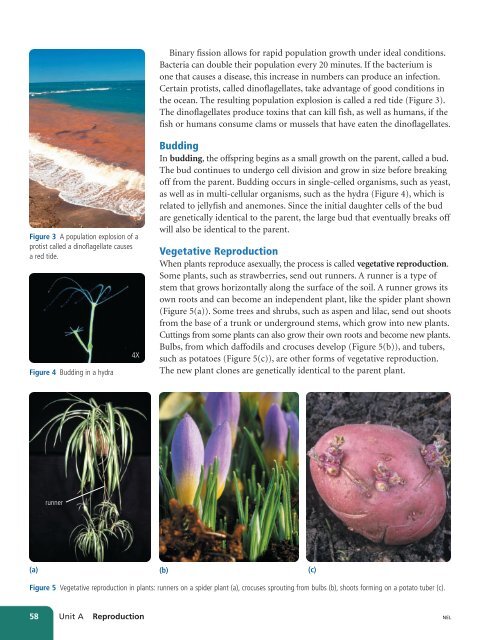Unit A Reproduction
Unit A Reproduction
Unit A Reproduction
You also want an ePaper? Increase the reach of your titles
YUMPU automatically turns print PDFs into web optimized ePapers that Google loves.
Binary fission allows for rapid population growth under ideal conditions.<br />
Bacteria can double their population every 20 minutes. If the bacterium is<br />
one that causes a disease, this increase in numbers can produce an infection.<br />
Certain protists, called dinoflagellates, take advantage of good conditions in<br />
the ocean. The resulting population explosion is called a red tide (Figure 3).<br />
The dinoflagellates produce toxins that can kill fish, as well as humans, if the<br />
fish or humans consume clams or mussels that have eaten the dinoflagellates.<br />
Figure 3 A population explosion of a<br />
protist called a dinoflagellate causes<br />
a red tide.<br />
Figure 4 Budding in a hydra<br />
4X<br />
Budding<br />
In budding, the offspring begins as a small growth on the parent, called a bud.<br />
The bud continues to undergo cell division and grow in size before breaking<br />
off from the parent. Budding occurs in single-celled organisms, such as yeast,<br />
as well as in multi-cellular organisms, such as the hydra (Figure 4), which is<br />
related to jellyfish and anemones. Since the initial daughter cells of the bud<br />
are genetically identical to the parent, the large bud that eventually breaks off<br />
will also be identical to the parent.<br />
Vegetative <strong>Reproduction</strong><br />
When plants reproduce asexually, the process is called vegetative reproduction.<br />
Some plants, such as strawberries, send out runners. A runner is a type of<br />
stem that grows horizontally along the surface of the soil. A runner grows its<br />
own roots and can become an independent plant, like the spider plant shown<br />
(Figure 5(a)). Some trees and shrubs, such as aspen and lilac, send out shoots<br />
from the base of a trunk or underground stems, which grow into new plants.<br />
Cuttings from some plants can also grow their own roots and become new plants.<br />
Bulbs, from which daffodils and crocuses develop (Figure 5(b)), and tubers,<br />
such as potatoes (Figure 5(c)), are other forms of vegetative reproduction.<br />
The new plant clones are genetically identical to the parent plant.<br />
runner<br />
(a)<br />
(b)<br />
(c)<br />
Figure 5 Vegetative reproduction in plants: runners on a spider plant (a), crocuses sprouting from bulbs (b), shoots forming on a potato tuber (c).<br />
58 <strong>Unit</strong> A <strong>Reproduction</strong><br />
NEL

















